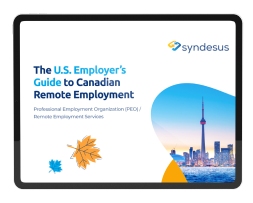With access to some of the world’s top universities, the United States has historically been a magnet for international students seeking higher education. However, an emerging trend sees these talented individuals looking outside the US for employment opportunities once they graduate.
Global talent visas, such as those offered by the UK, Australia, and Canada are attracting individuals with highly sought-after skills offering a simple immigration process and a clear pathway to permanent residence and citizenship as an incentive.
This article delves into one of the main catalysts behind this shift — US immigration challenges — and how US employers can still hire and retain talented individuals in today’s competitive market, even with immigration barriers. Let’s dive in.
How is the H-1B visa steering international graduates away from US employment?
At the heart of the matter lies the H-1B visa, which is a critical stepping stone for international students seeking long-term employment in the United States. When international students enter the US for their studies, they do so on an F-1 student visa. Accompanying this visa is the Optional Practical Training (OPT) program, which provides these students with the opportunity to work for one year after graduation in their field of study. For those who graduate with a STEM degree and secure employment in a STEM field, this period is extended to three years.
The majority of these students intend to continue working in the US beyond the OPT duration, but the reality is that only 11 percent of foreign-born US university bachelor’s degree recipients and 23 percent who get master’s degrees manage to stay and work in the United States. And the primary reason for this is the H-1B visa process. Required for most international students who want to work in the US, obtaining an H-1B visa has become increasingly challenging in recent years. Applicants are increasingly facing hurdles such as low selection rates and stringent requirements. This was starkly evident in 2023, when 780,884 applications were filed for H-1B visas, with just 14.6% of eligible H-1B registrations being selected for the 2024 fiscal year, leaving many disappointed.
Having invested years of their lives and significant financial resources into obtaining a US education, along with gaining 1-2 years of work experience in the country, F-1 visa holders working on OPT are understandably left deflated when their H-1B application isn’t selected in the lottery. This visa bottleneck is, in essence, one of the primary factors steering international talent toward opportunities beyond US borders. While there are calls for change, it remains uncertain whether any real modifications will take place that would alleviate the challenges of the H-1B process.
What are the alternatives for US companies?
So how can US employers avoid losing valuable talent to companies abroad? The solution is to get creative and hire those individuals remotely utilizing other countries’ more favorable immigration pathways, such as Canada’s Global Talent Stream (GTS).
By working with a third-party employment service such as an Employer or Record (EOR) or a Professional Employer Organization (PEO), companies can hire abroad even if they don’t have an office in that country. A PEO or EOR can take care of compliance with employment laws in any country your business is operating in as well as many of the technical aspects of employment such as HR, payroll, tax requirements, and employee benefits. They both ultimately offer an easier way for companies to hire remote employees in another country and take advantage of a global talent pool.
For companies with existing offices in those countries, the process becomes relatively straightforward. They can hire the individuals locally and potentially transfer them to their US entity in the future if required. For these companies, working with a PEO can be beneficial as the liability of the employee remains with the US company, but the PEO handles the HR, taxes, and other administrative functions that the US company may not want to hire full-time for.
On the other hand, for companies without a presence in those countries, partnering with an EOR allows them to easily navigate the complexities of remote hiring without needing an office abroad. The EOR essentially becomes the firm’s local employer from a legal liability standpoint but the employee’s duties remain in the hands of the US company.
Losing a talented employee is never ideal, but by employing creative immigration strategies American companies can bypass H-1B woes and focus on business.
Syndesus can help US-based companies keep their F-1/OPT workers
If you’re a US-based company facing challenges retaining F-1/OPT students then Syndesus can help by hiring them remotely in Canada. Whether your company already has a small office in Canada or no office at all, we can assist with our turnkey PEO or EOR services.
As a Canadian Employer of Record, Syndesus is able to hire tech workers remotely on behalf of US employers, which means that the immigration, payroll, HR, tax, and other administrative processes of your US-based company are taken care of while you focus on expanding your workforce and moving your business forward.
Reach out to us to learn more about how we can help you hire and retain talent remotely in Canada.






